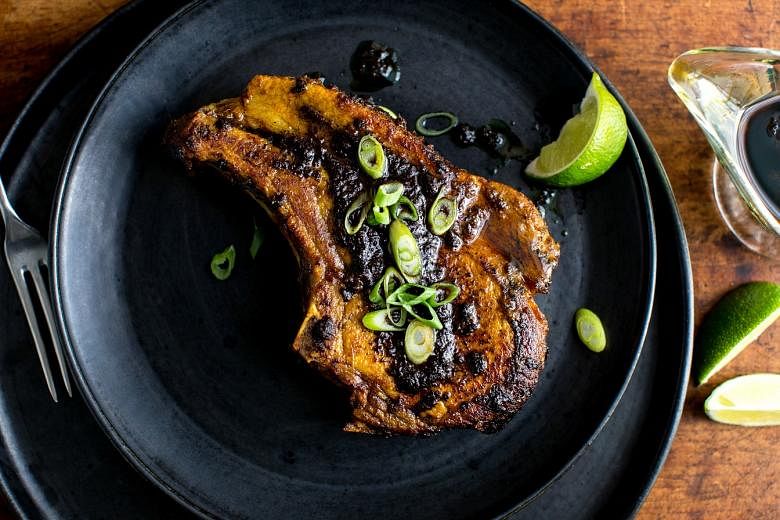NEW YORK (NYTimes) - As the availability of good, fat-marbled pork has risen, so has my adoration of that stalwart favourite, the bone-in pork chop.
Things used to be different.
For years, pigs were put on a diet, then served up lean and mean, without much internal fat to lubricate and flavour their brawny flesh. (Remember "the other white meat" ad campaign?)
The result was often chewy, bland and dry. Not nearly as good as bacon and therefore, in my mind, not worth eating.
You can still certainly find lean pork chops, and if you like them, feel free to use them in this recipe. But the more succulent, dark pink meat of thick-cut chops, most likely raised on small farms, is probably in the supermarket refrigerator case right alongside the skinnier chops. Look for a creamy layer of fat surrounding the meat and bone - this is a sign of something good.
For the cook, the fat serves several purposes: It insulates the meat, keeping it juicier for longer, giving you a larger margin of error when it comes to cooking. Even if you overshoot your target temperature, the fat protects the flesh, keeping it moist.
Fat also adds flavour, meaning you don't need to do too much to your chops beyond adding a generous sprinkle of salt and pepper to make them taste fantastic.
-
Pork Chops With Tamarind and Ginger
-
Ingredients
3 garlic cloves, finely grated or minced
1 Tbs tamarind concentrate (or extract), or use lime juice
1 Tbs sambal oelek or other chilli paste
2 tsp grated fresh ginger
2 tsp kosher salt, more as needed
1 1/2 tsp ground cumin
1 tsp fish sauce
1 tsp ground turmeric
2 bone-in pork chops, 1 1/2 inches (about 4cm) thick (about 900g in total)
2 Tbs coconut oil, grapeseed oil or safflower oil
Scallions, thinly sliced
Lime wedges, for serving -
Method
1. In a large bowl, combine garlic, tamarind, sambal oelek, ginger, salt, cumin, fish sauce and turmeric. Rub mixture evenly over pork, and let marinate for at least 1 hour and up to overnight.
2. Heat oven to 205 deg C. Heat oil in a cast-iron skillet over medium-high heat. Scrape the marinade off the pork, reserving it (there will be a tablespoon or two), then place chops in pan and sear on one side until well browned, 2 to 3 minutes. Use tongs to hold pork chops vertically to sear the fat on the edges, another 2 to 3 minutes.
3. Flip pork so browned side is on top and add reserved marinade to pan, stirring it into the drippings. Transfer pan to oven and cook to desired doneness, about 8 minutes for lightly pink on the inside (57 deg C). Transfer chops to a plate or cutting board and let rest for 5 minutes. Slice the meat off the bone and serve slices coated with pan drippings, scallions and lime wedges.
Time: 20 minutes, plus 1 hour's marinating Yield: 4 servings
This said, marinating the chops can make them even better. Here, I smear them with a paste of turmeric, tamarind, cumin, chilli, garlic, ginger and a touch of fish sauce. It is not a flavour combination that is authentic to any one place, but the sour, pungent and salty notes all go together beautifully.
A brief stint of high-heat searing followed by a jaunt to the oven allows the edges of the chops to caramelise and the center to cook a little more slowly. If you are grilling instead of roasting, a combination of direct heat and indirect heat yields similar results.
I like my pork chops cooked between medium-rare and medium, with meat that's distinctly pink and juicy. I aim for an internal temperature of 135 degrees and let the meat rest for a few minutes, allowing the temperature to rise and the juices to reabsorb. Then I carve it off the bone and serve it in slices.
With all the aromatics in the marinade, these chops do not need a sauce, though a spoonful or two of the drippings makes them glisten and intensifies their already wonderfully rich flavour: the taste of good, fatty pork.
And to Drink ...by Eric Asimov
The spicy, sour flavours of this dish are often tricky to pair with wine, but with good pork chops, they will simply accent the dominant savory richness of the meat.
Among whites, you could opt for a riesling, either a dry German or Austrian bottle, or a lightly sweet kabinett.
The herbal, peppery flavours of grüner veltliner would work well, as would a grassy, mineral sauvignon blanc as long as it is not oaky or tropical-fruity. You could try a pinot blanc or a sylvaner from Alsace.
If you prefer a red, I would look for something fresh, lightly fruity, with perhaps a touch of bitterness and no oak, like an inexpensive cabernet franc from the Loire Valley, a cru Beaujolais or maybe a dolcetto or barbera from northwestern Italy.


